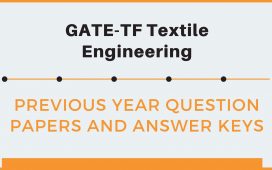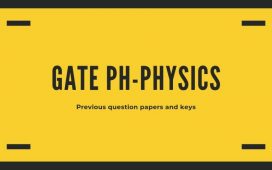Graduate Aptitude Test in Engineering (GATE) is an examination conducted by the Indian Institute of Science (IISc), Bangalore along with seven Indian Institutes of Technology to test the comprehensive understanding of the candidates in Science.
GATE Qualification is mandatory for seeking admission to:
(i) Master’s programs in Engineering/ Architecture/ Technology
(ii) Doctoral programs in relevant branches of Science, in the institutions supported by the MHRD and other Government agencies.
The GATE score is valid for Three Years from the announcement of the results.
A collection of previous year GATE EE Question papers along with answers are provided below to give a better understanding about GATE EE examination.
For latest updates on GATE 2019, visit http://gate.iitm.ac.in/
GATE 2020 EE Exam details
The duration of the GATE 2019 examination is 3 hours and the question paper consist of 65 questions for a total of 100 marks. The examination is conducted ONLINE and at the end of the stipulated time (3-hours), computer will automatically close the screen inhibiting any further action.
A candidate can appear only in any ONE paper of the GATE examination.
Pattern of Question Papers– GATE 2020 EE
The exam contains two different types of questions:
(i) Multiple Choice Questions (MCQ)
Each MCQ would carry 1 or 2 marks each in all the papers and sections. These questions are objective in nature, and each will have a choice of four answers, out of which the candidate must choose the correct answer. Note that there will be negative marking for a wrongly selected answer. For 1-mark MCQ, 1/3 mark will be deducted for a wrong answer. Likewise, for 2-mark MCQ, 2/3 mark will be deducted for a wrong answer.
(ii)Numerical Answer Type (NAT) Questions
Each NAT question carry 1 or 2 marks each in all the papers and sections. For these questions, the answer is a signed real number, which needs to be entered by the candidate using the virtual numeric keypad on the monitor (keyboard of the computer will be disabled). No choices will be shown for these types of questions. The answer can be a number such as 10 or -10 (an integer only). The answer may be in decimals as well. There is no negative marking for a wrong answer in NAT questions.
GATE EE Syllabus
GATE Electrical Engineering paper contains the below mentioned topics for examination:
- Section 1: Engineering Mathematics
Linear Algebra, Differential equations, Calculus, Probability and Statistics, Numerical Methods, Complex variables and Transform theory.
- Section 2: Electric Circuits
Network graph, KVL, KCL, Two-port networks, Thevenin’s theorem, Passive filters, Ideal current and voltage sources, Node and Mesh Analysis and Super position Theorem.
- Section 3: Electromagnetic Fields
Divergence, Electric Flux Density, Gauss’s Law, Capacitance of simple configurations, Biot‐Savart’s law, Ampere’s law, Curl, Faraday’s law, Lorentz force, Inductance and Magnetic circuits.
- Section 4: Signals and Systems
Applications of Fourier Transform, Laplace Transform and z-Transform, Shifting and scaling operations, Linear Time Invariant and Causal systems, Fourier series representation of continuous periodic signals, Sampling theorem and Representation of continuous and discrete‐time signals.
- Section 5: Electrical Machines
Three phase induction motors, Three phase transformers, DC machines, Operating principle of single-phase induction motors and Synchronous machines.
Section 6: Power Systems
Symmetrical components, Symmetrical and unsymmetrical fault analysis, Power generation concepts, ac and dc transmission concepts, Electric field distribution and insulators, Equal area criterion, cuit breakers, System stability concepts, Bus admittance matrix, Gauss-Seidel and Newton-Raphson load flow methods and Voltage and Frequency control.
- Section 7: Control Systems
Lead and Lead‐Lag compensators, Mathematical modeling and representation of systems, Transient and Steady‐state analysis of linear time invariant systems, State transition matrix, Routh-Hurwitz and Nyquist criteria, Bode plots, Root loci, Stability analysis and State space model.
- Section 8: Electrical and Electronic Measurements
Measurement of voltage, current, power, energy and power factor, Digital voltmeters and multimeters, Phase, Time and Frequency measurement; Oscilloscopes, Error analysis and Bridges and Potentiometers.
- Section 9: Analog and Digital Electronics
Schmitt trigger, Sample and hold circuits, A/D and D/A converters, 8085Microprocessor, Characteristics of diodes, BJT, MOSFET, Oscillators, Feedback amplifiers and Operational amplifiers.
- Section 10: Power Electronics
Characteristics of Diode, Thyristor, Triac, GTO, MOSFET, IGBT, Power factor, Distortion factor of ac to dc converters, Sinusoidal pulse width modulation, Single phase and three phase inverter, DC to DC conversion: Buck, Boost and Buck-Boost converters.
For Complete syllabus in PDF format click here
Link for the Previous Year Question Papers:
| Sl. No | Year of GATE
EE Exam |
Download Link |
| 1 | 2018 | Download |
| 2 | 2017 | Download |
| 3 | 2016 | Download |
| 4 | 2015 | Download |
| 5 | 2014 | Download |
| 6 | 2013 | Download |
| 7 | 2012 | Download |
| 8 | 1993-2011 | Download |








Good work sir
Thank you.. Its a great collection